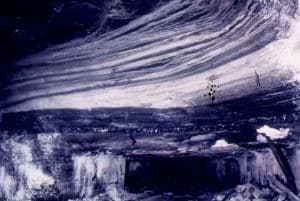Mining Topic: Geologic Characterization
What is the health and safety problem?
The U.S. underground mine worker faces a continuing hazard from roof falls and other ground control related hazards. Many injuries and fatalities are related to mine roof that is weakened as a result of geologic factors. The roof may consist of rock that is inherently low in strength such as drawrock, thinly bedded rock, or mudstone. Further, the roof may be weakened or damaged by discontinuities such as clay veins, slickensides, joints, faults, and paleochannels. Discontinuities, middleman members, changes in regional stress fields and other observable geologic factors may also negatively impact rib stability, which may result in rib-fall related accidents.
What is the extent of the problem?
Research relating to a wide range of geologic factors has contributed to the decline in the number of injuries and fatal accidents resulting from roof falls. However, according to Mine Safety and Health Administration (MSHA) statistics, 27,520 ground control related accidents were reported to MSHA between 2000 and 2021. These accidents resulted in more than 8,800 discrete injuries to underground workers, including 122 fatal events and 65 instances of permanent disability. Of those events reported to MSHA, 93% were classified as falls of roof or back.
How is the NIOSH Mining Program addressing this problem?

View of underground rock strata
The NIOSH Mining Program has developed, and is continuing to improve, methods for characterizing ground and its probable response to mining so that potential hazards can be identified and prevented.
The Underground Stone Mine Pillar Design in Challenging Conditions project seeks to, in part, improve support guidelines for underground stone mines through rock mass characterizations and exploratory investigations of material properties, stress conditions, geologic features, and measured pillar responses at target locations that support a parametric assessment of pillar stability.
The Unconventional Monitoring and Design for Mine Stability in Sedimentary Rock project seeks to improve geologic and ground condition assessments through the adaptation and enhancement of innovative non-invasive methodologies for underground settings, and also to evaluate the potential of geochemical markers as early risk indicators for gas outbursts.
What are the significant findings?
A number of tools – in particular classification and test methods – have been and continue to be developed. These include Coal Mine Roof Rating (CMRR) software, ground hazard mapping, ground condition mapping, diagnosis of moisture sensitivity, and gas content testing. Application of the CMRR is being improved through the development of enhanced, high definition borescopes to examine both roof and floor lithology as a part of the Integrated Analysis of Coal Pillar and Entry Stability project.
A Rock Mass Rating (RMR) was developed in conjunction with the University of Nevada, Reno, that addresses the deficits in rock characterization in those deposits that straddle the classification delineation between rock and soil. While developed for gold deposits, this Weak Rock Mass Rating (W-RMR) has application across many deposits and operations. It has been successfully applied as a part of the Durable Support for Western U.S. Underground Metal Mines project to develop support guidelines in weak-rock deposits.
What are the next steps?
Further development of classification and test methods will continue in order to improve the ability of mine workers to anticipate hazards well before they are exposed.
- Application of the Coal Mine Roof Rating (CMRR) to Extended Cuts
- An Approach to Identifying Geological Properties from Roof Bolter Drilling Parameters
- Building Capacity and Enhancing Long-Term Coal mine Weak Roof Stability through Characterization and Modeling of Time-Dependent and Moisture-Sensitive Failure in Shale
- CMRR - Coal Mine Roof Rating - 2.1.03
- Current trends in Reducing Ground Fall Accidents in US Coal Mines
- Current Trends in Reducing Ground Fall Accidents in US Coal Mines
- Diagnosing and Controlling Moisture-Sensitive Roof in Coal Mines
- Dynamic Failure in Deep Coal: Recent Trends and a Path Forward
- Geologic Hazards and Roof Stability in Coal Mines
- Ground Control Safety for Deep Vein Mines
- International Experience with Longwall Mining into Pre-Driven Rooms
- A Measurement Method for Determining Absorption Coefficients for Underground Mines
- Optimizing Secondary Roof Support with the NIOSH Support Technology Optimization Program (STOP)
- Proceedings of the International Workshop on Rock Mass Classification in Underground Mining
- Proceedings: New Technology for Ground Control in Multiple-seam Mining
- Roof and Rib Hazard Assessment for Underground Stone Mines
- Shale Failure Mechanics and Intervention Measures in Underground Coal Mines: Results from 50 Years of Ground Control Safety Research
- Stability Mapping to Examine Ground Failure Risk: A Field Study at a Limestone Mine
- Technology News 478 - Apparatus for Measuring the Gas Content of Coal or Rock Core Samples
- Technology News 526 - Proceedings of the International Workshop on Rock Mass Classification in Underground Mining
- Using the Coal Mine Roof Rating (CMRR) to Assess Roof Stability in U.S. Coal Mines